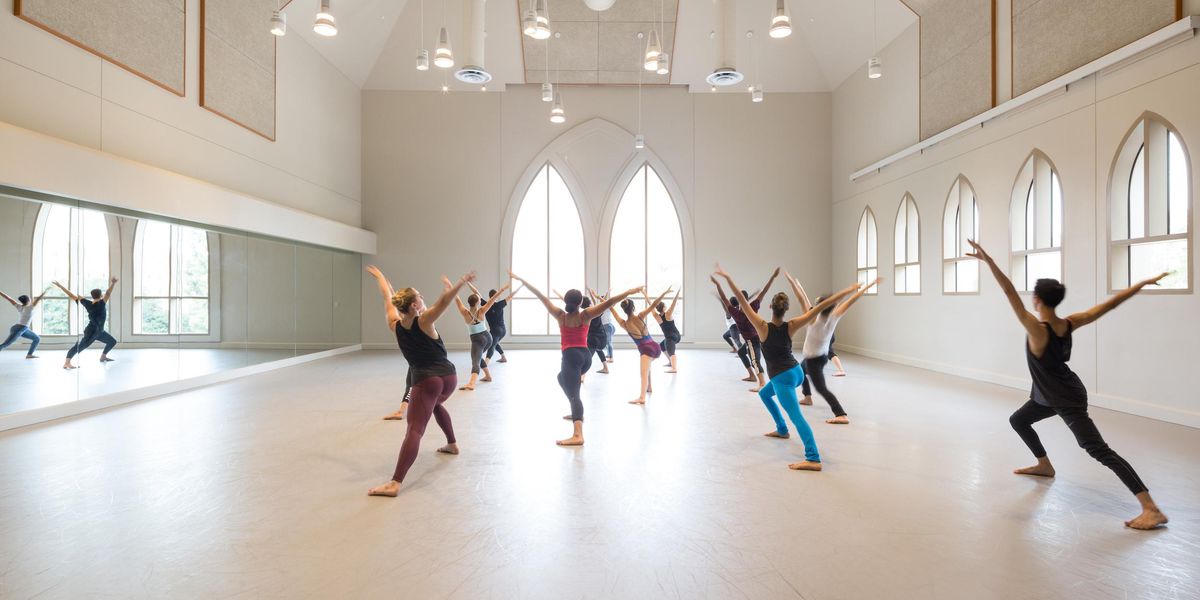Shostakovich Trilogy by Alexei Ratmansky
American Ballet Theatre, Metropolitan Opera House
New York, NY
May 31–June 3, 2013
At right: Polina Semionova and Marcelo Gomes in Ratmansky’s
Symphony #9. Photo by Marty Sohl, Courtesy ABT.
Alexei Ratmansky’s “Shostakovich Trilogy,” the most anticipated ballet premiere of the New York season, met lofty expectations. The choreographer, artist in residence at ABT, chose three diverse compositions, complemented by completely different sets by George Tsypin and costumes by Keso Dekker, as well as approaches to the dancing. Yet as varied as the sections are from one another, Shostakovich’s music and Ratmansky’s movement bind the evening into a grand, satisfying package that feels very much of Russia.
Symphony #9
(the music was composed in 1945), which premiered last year, paired contemporary-feel costumes—dark, painterly prints and flashes of gold) with a witty, backdrop of repeating Socialist Realist-style line-drawn images and red flags floating on grey, which identified this otherwise abstract dance as Russian. A playful couple (Craig Salstein, Simone Messmer) contrasts with a more mature, romantic pair (Polina Semionova, Marcelo Gomes); a lone man (Herman Cornejo) alternately darts about or anchors the roiling action like a watchful spirit. The music begins whimsically, becoming teasingly bombastic with brass flourishes. Salstein repeats a sliding move to a funny trombone line; Semionova retreats from, and is cosseted by, Gomes as a clarinet noodles along. The pair sinks to the floor, limb by limb, as if drugged, a motif which repeats later before Cornejo spins as if driving the earth’s rotation, leaping and collapsing with the curtain.
The second act, Chamber Symphony, is set to the composer’s same-titled 1960 work that opens with four notes, Shostakovich’s initials in German. Regarded as autobiographical, the music was written after he had joined the Communist party and visited a bombed-out Dresden. Accordingly, David Hallberg appears morose and alone, shirtless in a black suit; giant stone-faced masks hover above. He is at the mercy of the crowd, which lowers him or lifts him. Stepping aside, he removes himself from the action—the performance?—pushing his hair off his face casually (in the second cast, James Whiteside did the same). Hallberg often looks like a poet, and here he looked even more bereft and pensive than usual.
Chamber Symphony. Photo by Gene Schiavone, Courtesy ABT.
Three women (Paloma Herrera, Julie Kent, Isabella Boylston) either vie for or rebuff Hallberg’s attention. Are they graces, muses, phases of a life? At one point, they rock their hips side to side teasingly, and he seems to bubble atop their lightheartedness. But after an embrace, Herrera collapses to the floor, the scrim darkens, and Hallberg sulks before being dropped to the ground himself, parroting his compatriots. They rise, and four men hoist Herrera like a limp puppet folded at the waist onto Hallberg’s braced arms. Even in stasis, there’s a sense of agitation as the corps members freeze in a running pose. Hallberg seems to have an epiphany, and stands before the group like a conductor, overseeing an artful tableau, which parts for him as he walks offstage.
The finale, to Piano Concerto #1 (1933), is joyous and vibrant, nearly circus-like. Bright red geometric objects and vaguely Soviet iconography (hammers, a plane) are suspended in front of two intersecting, ominous dark triangles. The dancers, led by Diana Vishneva and Natalia Osipova in bright red tanks and Cory Stearns and Ivan Vasiliev in pewter unitards (making the muscle-bound Vasiliev look more wrestler than dancer), the corps wears half-silver, half-maroon leotards. Osipova and Vasiliev carve bold streaks of movement—slashing leaps, corkscrew assemblés. Stearns grabs Vishneva’s arm and simultaneously lifts and tethers her as she bounds around him. Each is pushing the limits of their considerable capacity, lit brightly by Jennifer Tipton, in contrast with the two prior, somberly lit sections.
Natalia Osipova and Ivan Vasiliev in Piano Concerto #1. Photo by Gene Schiavone, Courtesy ABT.
Ratmansky creates some arresting stage pictures. The corps bourrées on, flipping from front to back, colors alternating. The men bear the women on their shoulders in a sort of valiant winged victory line, slowly rotating sculptures crossing the stage. The cast forms a carnivalesque group pose, some in handstands, worthy of a Barnum & Bailey poster. Vasiliev, arms restrained by several men, stamps his feet like an angry bull; friendly horseplay enhances the sense of camaraderie. As Vasiliev does rudimentary ballet exercises as his pals whirl around him like a cyclone. Osipova and Vishneva conspire, huddling together. (And what a treat to see these two great ballerinas side by side.) Stearns and Vasiliev run through lines of bodies, like a football drill with tires. The red objects rises up to the flies leaving the black triangles, which grow larger and darker. Is it one era giving way to another, which promises modernism while bringing its own ominous bearings? Or simply a nod to minimalism, another Russian hallmark?
The trilogy was performed by two casts for just a handful of shows. In the second, Roberto Bolle and Veronika Part were suave and elegant in part one; Jared Matthews more jovial in the Cornejo role. Whiteside felt less a tormented artist than everyman as the composer’s doppelganger in the second section. And Christine Shevchenko, subbing for Gillian Murphy, sparkled in part three, dancing with attack and clarity alongside smooth, regal partner Calvin Royal III, while the magnetic Daniil Simkin paired with a breezy Xiomara Reyes.
This ambitious evening may profit from being split into separate dances; it is possibly too much of a good thing all at once. Ratmansky likes to keep the stage busy, often setting three scenes in action on one stage. Perhaps this is his nod to the unrelenting buzz of New York, but the trilogy’s heart belongs to Russia.




